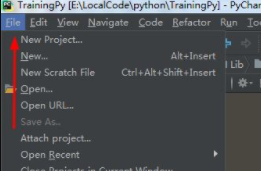前言
使用 Python 的时候,我们知道 list 是一个长度可变对的数组, 可以通过 insert,append 和 extend 轻易的拓展其中的元素个数。 也可以使用运算符 如: [1] + [2] 生成新的数组[1, 2]
extend()、"+"、"+="的区别
- "+"将两个 list 相加,会返回到一个新的 list 对象
- append 在原 list 上进行修改,没有返回值
从以下代码可以看到, 调用 b = b + [3, 4] 之后, 通过id(b) 查看 b 变成了一个新对象。
In [5]: b = [1, 2] In [6]: id(b) Out[6]: 1628740249224 In [7]: b = b + [3, 4] In [8]: id(b) Out[8]: 1628740456520
使用extend() 完成相同的步骤, 可以看到 对象c 的id保持和原来的一致
In [9]: c = [1, 2] In [10]: id(c) Out[10]: 1628740392584 In [11]: c.extend([3, 4]) In [12]: id(c) Out[12]: 1628740392584
使用 "+=" 连接列表, 看到效果和 extend() 是相同的。
In [1]: a = [1, 2] In [2]: id(a) Out[2]: 1628740021448 In [3]: a += [3, 4] In [4]: id(a) Out[4]: 1628740021448
结论: 减少内存的拷贝, 修改一个列表的数据时, 应避免使用 list1= list1+ list2 这样的语法。
List的内存使用
一个示例:
In [1]: import sys In [2]: lst1 = [1] In [3]: lst2 = [] In [4]: lst2.append(1) In [5]: lst1 == lst2 Out[5]: True In [6]: sys.getsizeof(lst1) Out[6]: 72 In [7]: sys.getsizeof(lst2) Out[7]: 96
可以看到,lst1 == lst2, 但是当使用 sys.getsizeof 获取对象的内存大小时, 两者却是不同的。
如下图所示, list_a 长度为4, 当执行 append(4) 时, 底层的数据长度其实申请了4个元素的空间,当再次执行 append(5) 的时候,不需要再次申请内存。

因为 执行 append() 操作时,Python将一次拓展N个元素的内存,因为一个 append 操作很可能是很多 append 操作的开始,通过额外分配内存来减少可能的内存分配和内存copy的次数。
In [1]: import sys
In [2]: l = []
...: print(f'list initial size {sys.getsizeof(l)}')
...: for i in range(80):
...: cur_size = sys.getsizeof(l)
...: l.append(i)
...: new_size = sys.getsizeof(l)
...: print(f'list len {i+1}:\t current_size {new_size}\t new_allocated 8 * {(new_size-cur_size)/8}')
...:
list initial size 64
list len 1: current_size 96 new_allocated 8 * 4.0
list len 2: current_size 96 new_allocated 8 * 0.0
list len 3: current_size 96 new_allocated 8 * 0.0
list len 4: current_size 96 new_allocated 8 * 0.0
list len 5: current_size 128 new_allocated 8 * 4.0
list len 6: current_size 128 new_allocated 8 * 0.0
list len 7: current_size 128 new_allocated 8 * 0.0
list len 8: current_size 128 new_allocated 8 * 0.0
list len 9: current_size 192 new_allocated 8 * 8.0
list len 10: current_size 192 new_allocated 8 * 0.0
list len 11: current_size 192 new_allocated 8 * 0.0
list len 12: current_size 192 new_allocated 8 * 0.0
list len 13: current_size 192 new_allocated 8 * 0.0
list len 14: current_size 192 new_allocated 8 * 0.0
list len 15: current_size 192 new_allocated 8 * 0.0
list len 16: current_size 192 new_allocated 8 * 0.0
list len 17: current_size 264 new_allocated 8 * 9.0
list len 18: current_size 264 new_allocated 8 * 0.0
list len 19: current_size 264 new_allocated 8 * 0.0
list len 20: current_size 264 new_allocated 8 * 0.0
list len 21: current_size 264 new_allocated 8 * 0.0
list len 22: current_size 264 new_allocated 8 * 0.0
list len 23: current_size 264 new_allocated 8 * 0.0
list len 24: current_size 264 new_allocated 8 * 0.0
list len 25: current_size 264 new_allocated 8 * 0.0
list len 26: current_size 344 new_allocated 8 * 10.0
list len 27: current_size 344 new_allocated 8 * 0.0
list len 28: current_size 344 new_allocated 8 * 0.0
list len 29: current_size 344 new_allocated 8 * 0.0
list len 30: current_size 344 new_allocated 8 * 0.0
list len 31: current_size 344 new_allocated 8 * 0.0
list len 32: current_size 344 new_allocated 8 * 0.0
list len 33: current_size 344 new_allocated 8 * 0.0
list len 34: current_size 344 new_allocated 8 * 0.0
list len 35: current_size 344 new_allocated 8 * 0.0
list len 36: current_size 432 new_allocated 8 * 11.0
list len 37: current_size 432 new_allocated 8 * 0.0
list len 38: current_size 432 new_allocated 8 * 0.0
list len 39: current_size 432 new_allocated 8 * 0.0
list len 40: current_size 432 new_allocated 8 * 0.0
list len 41: current_size 432 new_allocated 8 * 0.0
list len 42: current_size 432 new_allocated 8 * 0.0
list len 43: current_size 432 new_allocated 8 * 0.0
list len 44: current_size 432 new_allocated 8 * 0.0
list len 45: current_size 432 new_allocated 8 * 0.0
list len 46: current_size 432 new_allocated 8 * 0.0
list len 47: current_size 528 new_allocated 8 * 12.0
list len 48: current_size 528 new_allocated 8 * 0.0
list len 49: current_size 528 new_allocated 8 * 0.0
list len 50: current_size 528 new_allocated 8 * 0.0
list len 51: current_size 528 new_allocated 8 * 0.0
list len 52: current_size 528 new_allocated 8 * 0.0
list len 53: current_size 528 new_allocated 8 * 0.0
list len 54: current_size 528 new_allocated 8 * 0.0
list len 55: current_size 528 new_allocated 8 * 0.0
list len 56: current_size 528 new_allocated 8 * 0.0
list len 57: current_size 528 new_allocated 8 * 0.0
list len 58: current_size 528 new_allocated 8 * 0.0
list len 59: current_size 640 new_allocated 8 * 14.0
list len 60: current_size 640 new_allocated 8 * 0.0
list len 61: current_size 640 new_allocated 8 * 0.0
list len 62: current_size 640 new_allocated 8 * 0.0
list len 63: current_size 640 new_allocated 8 * 0.0
list len 64: current_size 640 new_allocated 8 * 0.0
list len 65: current_size 640 new_allocated 8 * 0.0
list len 66: current_size 640 new_allocated 8 * 0.0
list len 67: current_size 640 new_allocated 8 * 0.0
list len 68: current_size 640 new_allocated 8 * 0.0
list len 69: current_size 640 new_allocated 8 * 0.0
list len 70: current_size 640 new_allocated 8 * 0.0
list len 71: current_size 640 new_allocated 8 * 0.0
list len 72: current_size 640 new_allocated 8 * 0.0
list len 73: current_size 768 new_allocated 8 * 16.0
list len 74: current_size 768 new_allocated 8 * 0.0
list len 75: current_size 768 new_allocated 8 * 0.0
list len 76: current_size 768 new_allocated 8 * 0.0
list len 77: current_size 768 new_allocated 8 * 0.0
list len 78: current_size 768 new_allocated 8 * 0.0
list len 79: current_size 768 new_allocated 8 * 0.0
list len 80: current_size 768 new_allocated 8 * 0.0
通过观察可以发现, 列表从0 增加到 80长度的过程中, 新申请的内存长度为 [4, 4, 8, 9, 10, 11, 12, 13, 14, 16] 。 反之, 当执行 remove 或者 pop 减少列表中的数据时, 列表也会自动缩容。
- 扩容条件,新长度大于底层数组长度;
- 缩容条件,新长度小于底层数组长度的一半;
结论: 避免使用类似 append 语法初始化列表, 优先使用列表表达式
# Bad ❌ list_a = [] for i in range(50): list_a.append(i) # Good ✔️ list_b = [i for i in range(50)]
结论:
① 避免使用 "+" 修改数组
② 尽量避免多次使用 append 函数
到此这篇关于Python中的内存管理之python list内存使用详解的文章就介绍到这了,更多相关python list内存使用内容请搜索服务器之家以前的文章或继续浏览下面的相关文章希望大家以后多多支持服务器之家!
原文链接:https://blog.csdn.net/be5yond/article/details/120013569










